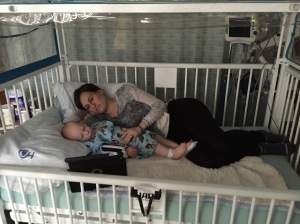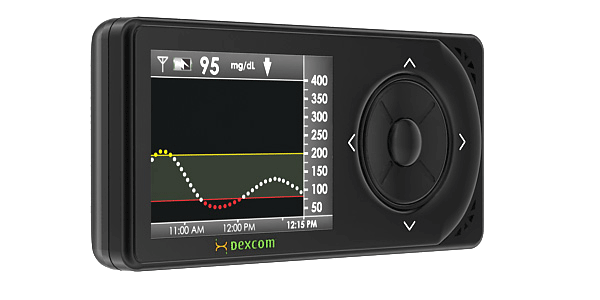
In honor of Diabetes Awareness Month I’ve decided to finally follow the advice and encouragement of friends and family and start a blog, detailing my experiences and newfound wisdom of being a mother of a child with type one diabetes. I’ve decided to kick off my blog by sharing our life altering experience when Liam was initially diagnosed with Diabetes.
T1Y1: Type 1 Diabetes Year One. This is what my son is referred to at the hospital we now frequent at minimum every three months. At the ripe bold age of 14.5 months, Liam was diagnosed with type 1 diabetes. Parents of children like Liam, who are diagnosed so young, typically find out their child has diabetes once their child is already in crisis. That is how we found out Liam was diabetic.
For a few weeks, Liam seemed aggressively thirsty and started peeing more than usual, soaking through his pajamas at night. A friend of mine from college was type 1 and I had never forgotten his description of his own onset, and because of that I started questioning whether Liam had diabetes. People thought I was crazy. We had no family history on either side and it was ludicrous to think a healthy, organic eating, breast fed baby could possibly have something like diabetes. I still couldn’t shake the feeling I had.
Liam began to get sick from what we thought was a bad cold; I was sick myself so it made sense. When he became incredibly lethargic I took him to his pediatrician. I shared with her my suspicions of diabetes but instead of finger pricking him in the office, she ignored my concerns and tested him for strep. When he tested positive, she chalked it all up to that. She ordered him antibiotics and sent us home. That evening as Liam threw up all over me and seemed to be getting sicker and sicker our fears continued to grow. We continued to call the pediatrician who continued to reassure us that this was Strep. Strep is hard on a little body, they said. But we couldn’t shake the feeling that this was something more.
The next day, Liam began to breathe differently, a labored sort of breathing, and could barely keep his eyes open. We were so scared. Little did we know at that time that we were literally watching our baby fight for his life. Had we listened to the pediatrician when she said this was normal and not taken him to the Emergency Room when we did, who knows what would have happened. As I’ve expanded my diabetes network I have learned of stories of parents not taking their child to the hospital in time. Children can have some very, very serious complications from being in Diabetic Keto Acidosis (DKA) for too long. One child I read about had been so sick her brain stem herniated into her brain leaving her paralyzed and debilitated for the 6 months she survived. I’m so grateful that we made it to the hospital in time to avoid some of the complications that others have been less fortunate to experience.
Nothing prepares you for watching your baby struggle to live. As nurses attempted to get needle after needle into my completely dehydrated baby, my husband and I watched on completely helpless. It was the worst feeling in the world. Liam was in DKA, diabetic ketoacidosis, a potentially fatal condition. His body was struggling to remove the excess sugar in his blood. His PH level was 6.9, a level the body can only sustain for a short period of time. Had we not taken him to the hospital when we did, had we followed the doctor’s orders, I have a hard time thinking about what could have happened to him.
Nothing prepares you for a life changing diagnosis. I will never forget the moment the ER doctor uttered the words “onset diabetic”. Those words crushed me like a ton of bricks. The doctors told us we needed to be transported in an ambulance to a hospital better suited to care for Liam, and only one parent could go. I rode in the ambulance next to Liam, who was hooked up to a machine to deliver fluids and insulin, and held his tiny hand while he went in and out of consciousness. We arrived at the Children’s Hospital of Philadelphia, an institution we are incredibly lucky to live near. They brought us to the PICU and I held Liam throughout that very long first night in the hospital. Doctors told us they would need to bring Liam’s blood sugar down slowly in order to avoid swelling of the brain. Every hour on the dot, the nurses came in to finger prick him and draw labs. They wouldn’t let me nurse him and that is all he wanted to do. It was by far, the hardest night of my life. I slept for maybe 45 minutes that night, unable to sleep with him laying on me and nurses waking him to check his blood glucose level so frequently.
In the morning his levels started to get better and by that afternoon they moved us to the Endocrine floor where we would spend the next three days learning how to keep Liam alive. My husband and I learned how to draw blood to test for glucose levels and how to inject him with insulin. We learned how to determine how much insulin he needs based on his glucose level and carbohydrates consumed. We learned what could happen to him if his blood sugar dropped too low–our first class we were introduced to a syringe we would need to give him to avoid him going into a coma. We learned how to treat high blood sugar. It was a steep learning curve but we became near-experts on type 1 diabetes in a matter of days.
After that long week, my husband and I became Liam’s lifeline. We serve as his pancreas, making decisions all day long about how to manage his blood sugar. It is a 24 hour, 7 day a week job with no rest. We wake up nearly every night, at least once, to correct a high or give him a syringe of maple syrup to bring up a low. It’s an exhausting job but one that is more worth it than any other position I will ever have. Welcome to the life of a pancreas.
 can I sleep when the constant worry of blood sugar keeps me up at night? The fear and anxiety wakes me as does the alarm on Liam’s continuous glucose monitor. Even when Liam’s blood sugar is in range I still wake up to nervously check his status. It’s utterly exhausting. The few nights I’ve slept away from Liam I still can’t really get away. I’ve texted my Dad and Mom at 3 am to check how he’s doing. Even though they know what they’re doing, I cannot escape my fear.
can I sleep when the constant worry of blood sugar keeps me up at night? The fear and anxiety wakes me as does the alarm on Liam’s continuous glucose monitor. Even when Liam’s blood sugar is in range I still wake up to nervously check his status. It’s utterly exhausting. The few nights I’ve slept away from Liam I still can’t really get away. I’ve texted my Dad and Mom at 3 am to check how he’s doing. Even though they know what they’re doing, I cannot escape my fear. 




